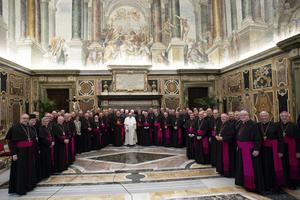Pope Francis Restores Beloved Marian Icon to Prominence
COMMENTARY: The Holy Father has had a devotion to Salus Populi Romani since his first days as pope.

Pope Francis offered Sunday Mass at the Basilica of St. Mary Major to celebrate the restoration of the beloved Marian icon Salus Populi Romani (Mary, Protectress of the Roman People).
In truth, it is the Holy Father himself who has restored Salus Populi Romani to prominence in Rome. Its artistic restoration followed a devotional resurgence led by Pope Francis, beginning on his first full day as pope.
It was from the central balcony of St. Peter’s, during his first appearance, that Francis announced that he would “go to the Madonna” the next day. Where would that be? There are no shortage of Marian images and churches in Rome. The new pontiff chose the most ancient basilica of St. Mary Major, in which is kept the Salus Populi Romani.
Just as various nations have their own Marian shrines with their distinctive Marian images, Salus Populi Romani is that for Rome, estimated to have arrived in the Eternal City from the East as early as the fifth century. It first came to prominence in 597, when Pope St. Gregory the Great had the image carried in procession through Rome during an outbreak of the plague.
Since that time, Romans have turned to the image in times of sickness (salus can be translated as “health”) or military danger (salus can also be translated as “salvation”).
Pope Francis turns to the image as a matter of regular piety. He has visited the image more than 50 times in his pontificate, usually praying there before every foreign trip and stopping there on his return home from the airport.
In this he is continuing a custom from his days as a cardinal when visiting Rome, when he would routinely visit St. Mary Major. That custom is not entirely unique; for example, Cardinal Timothy Dolan of New York usually stops at the papal Marian basilica after landing at the airport on his trips to Rome.
In honoring Salus Populi Romani, Pope Francis is extending a tradition of popes leaving a Marian mark in Rome, though usually at the Vatican.
At the end of his long pontificate, Pope Leo XIII had a replica of the Grotto at Lourdes built in the Vatican Gardens. In 1960, the original altar from Lourdes itself was given to St. John XXIII, who had it moved into the grotto at the Vatican.
In 1939, a monumental statue of Our Lady of Guadalupe and St. Juan Diego was added to the gardens. During the pontificate of St. John Paul II, Marian images multiplied rapidly, with Our Lady of Fatima, Our Lady of Jasna Gora and the Roman shrine of Our Lady of Divine Love also being added.
John Paul also installed the image of Mater Ecclesiae in St. Peter’s Square, so that there would be a Marian image visible when praying the Angelus.
With the coming of Pope Francis, Latin American devotion arrived in force, with the Marian images of Honduras, Panama, Cuba, Brazil and Bolivia all finding a home in the gardens since 2013.
It is amid these various Marian images in the gardens that Pope Benedict XVI used to walk while praying his afternoon Rosary, a custom he has kept up after his abdication, using a walker or golf cart when necessary.
It is notable that, while the Marian iconography of the Vatican has been increasing significantly over the past half-century, the Marian shrines in the city received comparatively less attention.
For example, both John Paul II and Francis had Our Lady’s statue from Fatima brought to Rome for acts of Marian consecration, instead of employing local Marian images.
The last major event focused on Salus Populi Romani was the procession that Venerable Pius XII staged in 1954 to mark the first ever Marian year. Pius XII — Eugenio Pacelli — was himself a Roman, choosing to offer his first Mass after ordination on the altar of Salus Populi Romani in St. Mary Major.
On Sunday, Pope Francis gave a lovely meditation on a familiar Marian prayer, also from the Eastern tradition, like Salus Populi Romani itself. He preached on the Sub Tuum Praesidium, the most ancient Marian antiphon:
Under your protection we seek refuge, Holy Mother of God: Do not despise the supplications of us who are undergoing trials, but deliver us from all danger, O glorious and Blessed Virgin.
“With her mantle, [Salus Populi Romani] shelters her children and covers the whole world,” preached the Holy Father Sunday. “Even the ancient monks recommended, in trials, to take refuge under the mantle of the Holy Mother of God. This wisdom, which comes from afar, helps us: The Mother guards faith, protects relationships, saves us in the storms and preserves us from evil. When Mary is in the home, the devil does not enter.”
As Pope Francis draws near to his fifth anniversary, the restoration of Salus Populi Romani is a suitable commemoration of his tender Marian devotion — and his trustworthy advice to put the devil to flight.
Father Raymond J. de Souza is editor in chief of Convivium magazine.
















